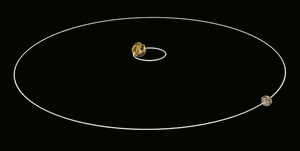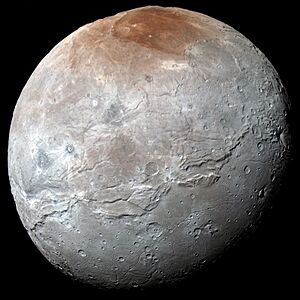Charon (moon) facts for kids
| Discovery | |
|---|---|
| Discovered by | James W. Christy |
| Discovery date | 22 June 1978 |
| Designations | |
| Pronunciation | SHARR-ən or KAIR-ən |
|
Named after
|
Charon |
| (134340) Pluto I | |
| Adjectives | Charonian |
| Orbital characteristics | |
| Epoch 2452600.5 | |
| 17536±4 km to system barycenter, 19571±4 km to the center of Pluto | |
| Eccentricity | 0.00 |
| 6.3872304±0.0000011 d (6 d, 9 h, 17 m, 36.7 ± 0.1 s) |
|
|
Average orbital speed
|
0.21 km/s |
| Inclination | 0.001° (to Pluto's equator) 119.591°±0.014° (to Pluto's orbit) 112.783°±0.014° (to the ecliptic) |
| 223.046°±0.014° (to vernal equinox) | |
| Satellite of | Pluto |
| Physical characteristics | |
|
Mean radius
|
606±3 km (0.095 Earths, 0.51 Plutos) |
| Flattening | <1% |
| 4.×106 km2 (0.0090 Earths) | |
| Volume | (9.32±0.14)×108 km3 (0.00086 Earths) |
| Mass | (1.586±0.015)×1021 kg (2.66×10−4 Earths) (12.2% of Pluto) |
|
Mean density
|
1.707±0.013 g/cm3 |
| 0.288 m/s2 | |
| 0.59 km/s 0.37 mi/s |
|
| synchronous | |
| Albedo | 0.2 to 0.5 at a solar phase angle of 15° |
| Temperature | −220 °C (53 K) |
| 16.8 | |
| 1 | |
| 55 milli-arcsec | |
Charon, also known as (134340) Pluto I, is the largest of the five known natural satellites that orbit the dwarf planet Pluto. It was discovered in 1978 at the United States Naval Observatory in Washington, D.C.
Charon is very large compared to Pluto. It is about half the size of Pluto and has one-eighth of its mass. Its strong gravity means that the center of the Pluto-Charon system is actually outside Pluto itself. The New Horizons spacecraft is the only probe that has visited the Pluto system. It flew past Charon, getting as close as about 27,000 kilometers (17,000 miles).
Contents
How Charon Was Found

Charon was discovered by an astronomer named James Christy on June 22, 1978. He was working at the United States Naval Observatory Flagstaff Station (NOFS). Christy was looking at very clear pictures of Pluto taken on special photographic plates. He noticed something unusual.
He saw that Pluto seemed to have a small bulge that appeared and disappeared regularly. This bulge was also seen in older pictures from 1965. Scientists soon realized that this bulge was actually a smaller body orbiting Pluto. The way the bulge moved matched Pluto's rotation. This proved that the bulge was real and not a mistake.
Finding Charon helped scientists learn more about Pluto. Before, they thought all the mass and brightness belonged to Pluto alone. But now they knew it was shared between Pluto and Charon. Any remaining doubts about Charon's existence disappeared between 1985 and 1990. During this time, Pluto and Charon passed in front of each other, causing mutual eclipses. This only happens at certain times in their long orbit. It was lucky that this period happened soon after Charon was discovered.
Naming Charon
When it was first found, Charon had a temporary name: S/1978 P 1. On June 24, 1978, James Christy suggested the name Charon. He chose it because it sounded scientific and was similar to his wife Charlene's nickname, "Char".
Later, Christy found out that Charon is also a figure in Greek mythology. Charon is the ferryman who carries the souls of the dead across a river. He is linked to the god Hades, whom the Romans called Pluto. The International Astronomical Union (IAU) officially approved the name in late 1985. It was announced on January 3, 1986.
How Charon Was Formed
Scientists believe Charon formed about 4.5 billion years ago. One idea is that a large object from the Kuiper belt crashed into Pluto. This crash would have created a lot of debris. Charon then formed from this debris, similar to how Earth's Moon formed.
However, this idea suggested Charon would be icier and Pluto rockier than they are. A newer idea suggests that Pluto and Charon were two separate bodies that collided. This crash was strong enough to boil off light ices, but not so strong that it destroyed either body. The fact that Pluto and Charon have similar densities supports this idea. It means they were not fully separated into layers when the impact happened.
Charon's Orbit

Charon and Pluto orbit each other every 6.387 days. They are also "gravitationally locked" to each other. This means that each body always shows the same side to the other. It's like how our Moon always shows the same face to Earth. But with Pluto and Charon, it's a mutual lock, so both always face each other.
The average distance between Charon and Pluto is about 19,570 kilometers (12,160 miles). Finding Charon helped astronomers accurately figure out the total mass of the Pluto system. Later, by studying the orbits of Pluto's other moons, scientists learned that Charon has about 12.18% of Pluto's mass. This means Charon is made of about 55% rock and 45% ice. Pluto is a bit denser, with about 70% rock.
What Charon Is Like
Charon's diameter is about 1,212 kilometers (753 miles). This is just over half the size of Pluto. It is also larger than the dwarf planet Ceres. Charon is the twelfth largest natural satellite in our Solar System.
Charon is massive enough that its own gravity has pulled it into a round shape. Because it rotates slowly, it is almost perfectly spherical. Its measurements from its equator to its poles differ by less than 1%.
Inside Charon
Scientists can figure out Charon's density from its size and mass. It is about 1.702 grams per cubic centimeter. This density tells us that Charon has a bit less rock and more ice inside than Pluto does.
Before the New Horizons spacecraft flew by, there were two main ideas about Charon's inside. Some scientists thought it had a rocky core with an icy outer layer, like Pluto. Others thought it was the same material all the way through. In 2007, signs of ammonia and water ice on Charon's surface suggested there might be active "cryogeysers." These are like geysers, but they shoot out icy water instead of hot water. This supports the idea of a layered interior. The ice was still in a crystalline form, which means it was likely deposited recently.
Charon's Surface
Pluto's surface is covered in nitrogen and methane ices. But Charon's surface is mostly made of water ice, which is less likely to evaporate. As mentioned, observations in 2007 suggested that Charon might have active cryogeysers and cryovolcanoes. These would be volcanoes that erupt with icy materials.
A Mountain in a Moat
One very unusual feature seen in a photo from New Horizons is a mountain rising out of a depression. It looks like a "large mountain sitting in a moat," according to Jeff Moore, a scientist from NASA’s Ames Research Center. He said this feature has geologists "stunned and stumped." New Horizons took this photo from about 49,000 miles (79,000 kilometers) away.
Studying Charon
The first clear images showing Pluto and Charon as separate objects were taken by the Hubble Space Telescope in the 1990s. These were the best pictures of Charon at the time. In 1994, Hubble's Faint Object Camera took a picture showing two distinct, clear circles. This was when the system was 4.4 billion kilometers (2.6 billion miles) from Earth. Later, new technology called adaptive optics allowed ground-based telescopes to also see Pluto and Charon as separate disks.
In June 2015, the New Horizons spacecraft took a series of images of the Pluto-Charon system as it got closer. These images were put together to make an animation. It was the clearest view of Charon ever seen. In July 2015, New Horizons made its closest approach to the Pluto system. It is the only spacecraft to have visited and studied Charon up close.
Images for kids
See also
 In Spanish: Caronte (satélite) para niños
In Spanish: Caronte (satélite) para niños







